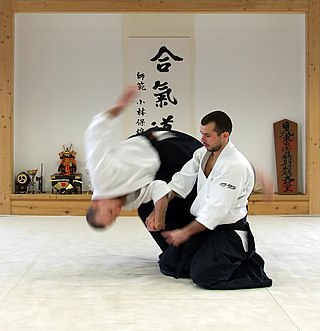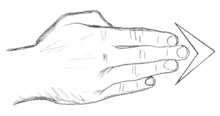
Aikido is a modern Japanese martial art that is split into many different styles, including Iwama Ryu, Iwama Shin Shin Aiki Shuren Kai, Shodokan Aikido, Yoshinkan, Renshinkai, Aikikai and Ki Aikido. Aikido is now practiced in around 140 countries. It was originally developed by Morihei Ueshiba, as a synthesis of his martial studies, philosophy and religious beliefs. Ueshiba's goal was to create an art that practitioners could use to defend themselves while also protecting their attackers from injury. Aikido is often translated as "the way of unifying (with) life energy" or as "the way of harmonious spirit". According to the founder's philosophy, the primary goal in the practice of aikido is to overcome oneself instead of cultivating violence or aggressiveness. Morihei Ueshiba used the phrase masakatsu agatsu katsuhayabi" to refer to this principle.

Kickboxing is a full-contact combat sport and a form of boxing based on punching and kicking. The fight takes place in a boxing ring, normally with boxing gloves, mouth guards, shorts, and bare feet to favor the use of kicks. Kickboxing is practiced for self-defense, general fitness, or for competition. Some styles of kickboxing include: Karate, Muay Thai, Japanese kickboxing, Lethwei, Sanda, and Savate.

A kick is a physical strike using the leg, in unison usually with an area of the knee or lower using the foot, heel, tibia (shin), ball of the foot, blade of the foot, toes or knee. This type of attack is used frequently by hooved animals as well as humans in the context of stand-up fighting. Kicks play a significant role in many forms of martial arts, such as capoeira, karate, kickboxing, kung fu, MMA, Muay Thai, pankration, pradal serey, savate, sikaran, silat, taekwondo, vovinam, and Yaw-Yan. Kicks are a universal act of aggression among humans.

Shitō-ryū (糸東流) is a form of karate that was founded in 1934 by Kenwa Mabuni. Shitō-ryū is synthesis of the Okinawan Shuri-te and Naha-te schools of karate and today is considered one of the four main styles of the art.

Kumite is one of the three main sections of karate training, along with kata and kihon. Kumite is the part of karate in which a person trains against an adversary.

In martial arts, blocking is the act of stopping or deflecting an opponent's attack for the purpose of preventing injurious contact with the body. A block usually consists of placing a limb across the line of the attack.

A strike is a directed, forceful physical attack with either a part of the human body or with a handheld object, intended to cause blunt or penetrating trauma upon an opponent.

Tsuki (突き) derives from the verb tsuku (突く), meaning "to thrust". The second syllable is accented, with Japanese's unvoiced vowels making it pronounced almost like "ski". In Japanese martial arts and Okinawan martial arts, tsuki is used to refer to various thrusting techniques.
Strikes can be offensive moves in professional wrestling, that can sometimes be used to set up an opponent for a hold or for a throw. There are a wide variety of strikes in pro wrestling, and many are known by several different names. Professional wrestlers frequently give their finishers new names. Occasionally, these names become popular and are used regardless of the wrestler performing the technique.

Iron palm or iron hand is a body of training techniques in various Chinese martial arts. It is deeply rooted in Traditional Chinese Medicine and Taoist concepts, and is one of the original 72 arts of the Shaolin temple. These conditioning techniques are typically meant to condition the hands, including the forearms and elbows to allow a practitioner to deliver very powerful blows without injury to their hands.

The front kick in martial arts is a kick executed by lifting the knee straight forward, while keeping the foot and shin either hanging freely or pulled to the hip, and then straightening the leg in front of the practitioner and striking the target area. It is desirable to retract the leg immediately after delivering the kick, to avoid the opponent trying to grapple the leg and to return to stable fighting stance.
"Leopard Blow," "leopard punch," and "leopard fist" are common terms for a specific type of striking blow, associated primarily with the Leopard Kung Fu substyle of the Five Animals in Chinese martial arts, though it is also used in styles such as Krav Maga, Choy Li Fut and Karate. The maneuver involves folding the first two joints of the fingers inward and striking with the fore-knuckles. It is used most often to strike at soft, vulnerable targets, such as the ribs, throat, inner arms and temples.
A taunt is a battle cry, sarcastic remark, gesture, or insult intended to demoralize the recipient, or to anger them and encourage reactionary behaviors without thinking. Taunting can exist as a form of social competition to gain control of the target's cultural capital. In sociological theory, the control of the three social capitals is used to produce an advantage in the social hierarchy, so as to enforce one's own position in relation to others. Taunting is committed by either directly or indirectly encouraging others to taunt the target. The target may give a response in kind to maintain status, as in fighting words and trash-talk.

In martial arts, a knifehand strike is a strike using the part of the hand opposite the thumb, familiar to many people as a karate chop. Suitable targets for the knifehand strike include the carotid sinus at the base of the neck, mastoid muscles of the neck, the jugular, the throat, the collar bones, ribs, sides of the head, temple, jaw, the third vertebra, the upper arm, the wrist, the elbow, and the knee cap.
Jujutsu techniques include joint locks, chokeholds, strikes, grappling, throwing, and other self-defense techniques.
The Karate World Championships, also known as the World Karate Championships, are the highest level of competition for karate organized by the World Karate Federation (WKF). The competition is held in a different city every two years. Championships in the 2000s included Madrid in 2002, Monterrey in 2004, Tampere in 2006, Tokyo in 2008, and Belgrade in 2010. The competition was initially riddled with controversy regarding karate styles and the ruleset.
Aikido techniques are frequently referred to as waza 技. Aikido training is based primarily on two partners practicing pre-arranged forms (kata) rather than freestyle practice. The basic pattern is for the receiver of the technique (uke) to initiate an attack against the person who applies the technique—the 取り tori, or shite 仕手, also referred to as (投げ nage, who neutralises this attack with an aikido technique.

The term Haitō means the inner edge of the hand, hand edge of the thumb side. One reaches out the four fingers, bends the first joint of the thumb and presses it against the side of the palm.













